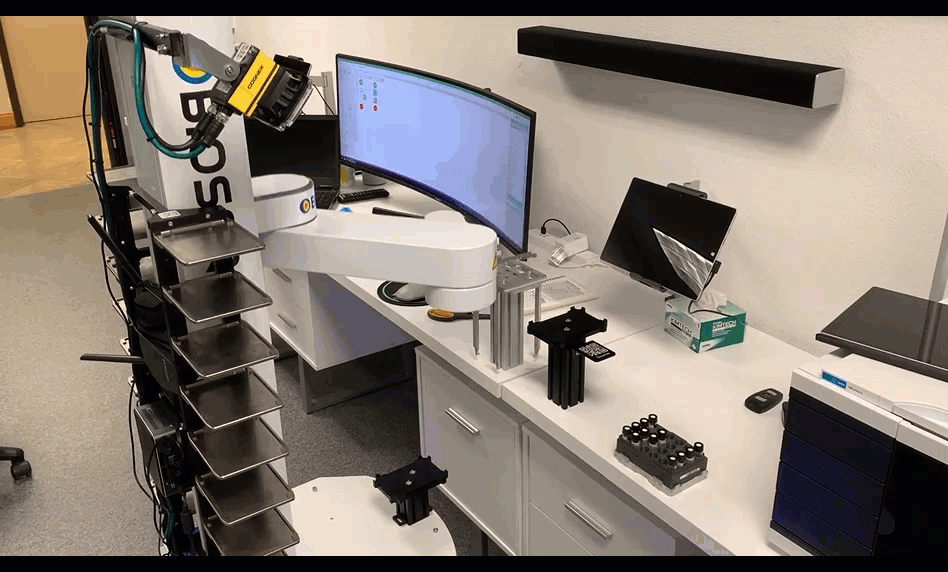When you think of laboratory automation, you might think of large robotic arms — the kinds that are bolted in place next to instruments they load with samples. But as automation evolves, customers are getting new options that tend to be more mobile, flexible, and agile.
What are autonomous mobile robots?
Autonomous mobile robots are a recent addition to automation systems, and they offer a degree of flexibility that was never possible before. These robots use sensors to independently navigate their environment and work around people and instruments in the lab. We think of them as Roombas on steroids! They can easily move samples among instruments in the same lab or transport them to labs on separate floors or in different buildings.
Mobile robots are designed to work collaboratively with scientists to perform tasks as efficiently as possible. Because they can move, scientists who use them can set up their labs in new ways. For example, scientists who run next-generation sequencing experiments can break up their processes into multiple workstations that do not have to be located next to each other. They can then program mobile robots to move hundreds or thousands of samples from one station to the next.
And these robots can operate without much oversight. Scientists can run experiments during the day and then feed mobile robots with the consumables they need to continue running assays through the night. All scientists have to do is retrieve and analyze the results in the morning.

4 more ways mobile robots improve lab workflows:
1. Improved efficiency and time savings
Mobile robots are engineered to streamline repetitive and time-consuming tasks, empowering researchers to focus on high-value activities. With their ability to navigate autonomously and perform various functions, mobile robots eliminate the need for manual intervention in time consuming activities like sample transportation, inventory management, and equipment handling. By taking over these routine tasks, mobile robots free up valuable human resources, enabling lab staff to allocate their time more effectively, accelerating research timelines, and fostering greater scientific productivity.
2. Increased safety to human operators
Laboratories often house hazardous substances and delicate equipment, posing potential risks to human operators. By deploying mobile robots, lab personnel can reduce their exposure to dangerous chemicals, biohazards, and other safety risks. These advanced machines are built with advanced sensing technologies, enabling them to detect and navigate around obstacles, thus minimizing the risk of accidents or spills. Moreover, these robots can be programmed to handle fragile samples with great care, minimizing the chances of damage or contamination. This integration of robotics technology not only ensures a safer working environment but also safeguards valuable research materials.

3. Precise and consistent operations:
The accuracy and precision demanded by scientific experiments are critical for obtaining reliable results. Human errors, however unintentional, can lead to inconsistencies and variations in laboratory procedures. Mobile robots, on the other hand, execute tasks with accuracy and repeatability, eliminating the potential for human-induced errors. This level of precision can significantly contribute to the reproducibility of scientific research.
4. Next level data collection and analysis:
More than ever before, data plays a crucial role in scientific advancements. Mobile robots can be integrated with laboratory instruments to collect and transmit real-time data. This capability enables researchers to monitor experiments remotely and capture a wealth of information, expanding the scope and depth of their investigations.

Biosero as a mobile robot partner
Biosero was one of the first companies to incorporate mobile robots in the lab environment. While we don’t typically focus on hardware, we got into mobile robots because they offered clear value for our customers, and no other automation providers were making them readily available. We have had plenty of time to understand how they work best, and we have used that knowledge to develop advanced functionality for our Green Button Go® software that lets our customers implement mobile robots in their labs.
With Green Button Go, scientists can manage all kinds of workflows and tasks through their mobile robots. Our software can integrate fully automated or non-automated systems, and we can train these robots to move seamlessly between buildings or labs. Our software is hardware-agnostic, so it can work with any type of mobile robots available on the market.
The Green Button Go software suite is also already configured to work with a specific fleet of mobile robots that Biosero carries. Once you share your lab layout and goals with our team, we can help get these handy machines working in your lab quickly.
From there, you can configure different devices and define processes and tasks for the mobile robots with an intuitive architecture, capture data from different lab processes for downstream analysis, and manage experiments all from a centralized interface.
The integration of mobile robots in the laboratory setting unlocks a multitude of benefits, revolutionizing the way research is conducted. From optimizing efficiency and ensuring safety to improving precision and, these intelligent machines are reshaping scientific workflows. Switching to mobile robots means that scientists no longer have to install dedicated infrastructure within easy reach of a robotic arm or set up conveyor belts just to transport samples in the lab. If you are interested in using these robots in your lab or have already purchased some new robots and need software that can integrate them into your existing infrastructure, our team is ready to help. Please reach out to discuss your needs.
Ready to see mobile robots at work?
Book a tour of the Biosero Acceleration Lab where you can see our mobile robot interacting with a variety of automated equipment such as automated incubators, liquid handlers, imaging systems, and a wide variety of devices used in research and production labs.
